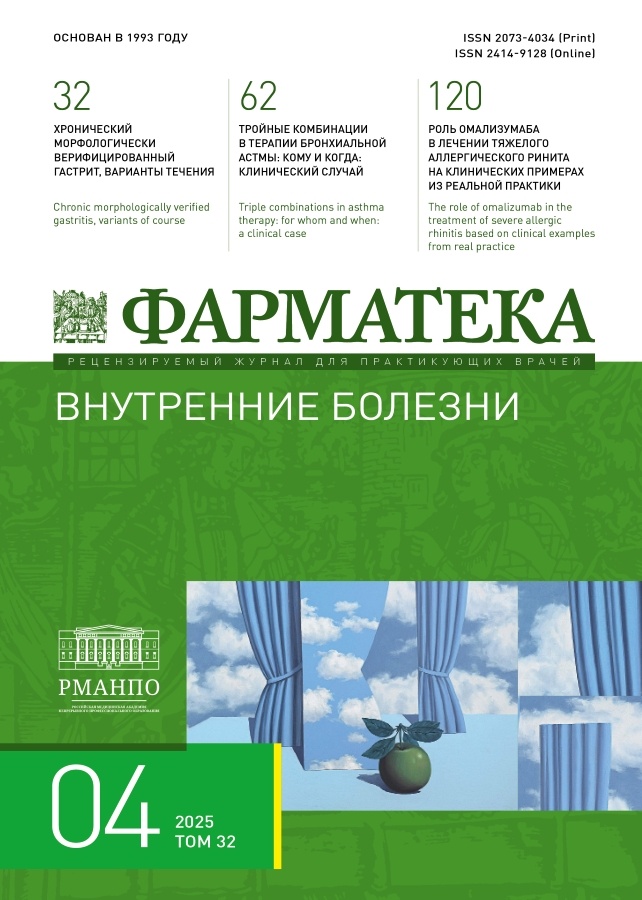Comparative analysis of the microbial landscape of the surgical departments of multidisciplinary hospitals in Petrozavodsk (Republic of Karelia)
- Autores: Ryabkova N.L.1,2, Ilyina N.A.3, Gromova G.A.4, Ryabkov V.A.1,2
-
Afiliações:
- Petrozavodsk State University
- Republican Hospital named after V.A. Baranov
- Republican Hospital of Emergency and Intensive Medical Care
- Republican Oncology Dispensary
- Edição: Volume 32, Nº 4 (2025)
- Páginas: 212-220
- Seção: Восстановительная медицина
- URL: https://journals.eco-vector.com/2073-4034/article/view/687771
- DOI: https://doi.org/10.18565/pharmateca.2025.4.212-220
- ID: 687771
Citar
Texto integral
Resumo
Background: Antimicrobial resistance is one of the most pressing problems in healthcare, including in developed countries. Local monitoring is necessary for timely correction of protocols for empirical antimicrobial therapy of nosocomial infections in a particular medical institution and for implementation of anti-epidemic measures.
Objective: Comparative analysis of the etiological structure and sensitivity of the main pathogens of nosocomial infections in surgical departments to antimicrobial drugs (AMDs) in 2023 in three multidisciplinary hospitals of Petrozavodsk: the Republican Hospital named after V.A. Baranov (RH), the Republican Hospital of Emergency and Intensive Medical Care (RHEIC) and the Republican Oncology Dispensary (ROD).
Materials and methods: An analysis of all microbiological studies performed in 2023 in three third-level hospitals of Petrozavodsk was carried out. A data summary, statistical grouping, and subsequent graphical presentation of the information obtained were carried out.
Results: Among the microbiological studies in the intensive care units, sputum tests prevailed. The main causative agents of nosocomial lower respiratory tract infections in the RH and RHRIC were Klebsiella pneumoniae (34.88 and 35.23%), Staphylococcus aureus (19.77 and 19.32%), Acinetobacter baumannii (15.12 and 10.22%) and Pseudomonas aeruginosa (8.14 and 10.22%). In the RH A. baumannii was resistant to all AMDs and all leading pathogens were not very sensitive to ceftazidime. Wound discharge was examined more often in the surgical departments of all hospitals: S. aureus prevailed in the RH, while Escherichia coli prevailed in the other two hospitals. Low sensitivity of gram-negative pathogens to amikacin was noted in the RH, as well as low sensitivity of K. pneumoniae and P. aeruginosa to AMDs in the ROD. In the urology departments, all microbiological studies were represented by urine cultures, the main pathogens were E. coli, K. pneumoniae and Enterococcus spp. Low sensitivity to all AMDs was typical for K. pneumoniae in the RH and the ROD, to ceftazidime - in the RHEIC, and P. aeruginosa to ceftazidime in the RH. In the traumatology departments of the RH and the RHEIC, wound discharge studies were predominant (84.05 and 86.67%), with S. aureus being the leading pathogen. The sensitivity of K. pneumoniae to amikacin, as well as to ceftazidime in all the main gram-negative pathogens in the RH was below the optimal values. The leading causative agent of wound infection in the neurosurgical department of the RH was S. aureus, in the RHEIC – E. coli. Low sensitivity of K. pneumoniae and Proteus spp. to all AMDs was noted, and P. aeruginosa – to ceftazidime in the RH.
Conclusion: In the surgical departments of the three leading multidisciplinary hospitals of Petrozavodsk, gram-negative microflora in combination with S. aureus predominates as causative agents of nosocomial infections. Lower sensitivity of gram-negative pathogens to AMDs was registered in the RH and the ROD.
Texto integral
Sobre autores
Nadezhda Ryabkova
Petrozavodsk State University; Republican Hospital named after V.A. Baranov
Autor responsável pela correspondência
Email: nadl-ryabkova@yandex.ru
ORCID ID: 0000-0002-9434-7931
Código SPIN: 3652-4255
Cand. Sci. (Med.), Associate Professor, Department of Hospital Therapy, Medical Institute, Petrozavodsk State University; Clinical Pharmacologist, Republican Hospital named after V.A. Baranov
Rússia, Petrozavodsk; PetrozavodskNatalya Ilyina
Republican Hospital of Emergency and Intensive Medical Care
Email: nadl-ryabkova@yandex.ru
ORCID ID: 0009-0001-9555-1715
Clinical Pharmacologist
Rússia, PetrozavodskGalina Gromova
Republican Oncology Dispensary
Email: nadl-ryabkova@yandex.ru
ORCID ID: 0009-0008-2406-7767
Clinical Pharmacologist
Rússia, PetrozavodskVadim Ryabkov
Petrozavodsk State University; Republican Hospital named after V.A. Baranov
Email: nadl-ryabkova@yandex.ru
ORCID ID: 0000-0002-3353-3220
Cand. Sci. (Med.), Associate Professor, Center for Postgraduate Education of the Medical Institute, Petrozavodsk State University; Cardiologist, Republican Hospital named after V.A. Baranov
Rússia, Petrozavodsk; PetrozavodskBibliografia
- Методические рекомендации «Диагностика и антимикробная терапия инфекций, вызванных полирезистентными штаммами микроорганизмов (обновление 2022 г.)». URL: https://www.antibiotic.ru/iacmac/news/obnovlennye-metodicheskie-rekomendacii-diagnostika-i-antimikrobnaya-terapiya-infekcij-vyzvannyh-polirezistentnymi-shtammami-mikroorganizmov (ссылка доступна на 15.02.2025). [Guidelines «Diagnostics and antimicrobial therapy of infections caused by multidrug-resistant strains of microorganisms (2022 update)». URL: https://www.antibiotic.ru/iacmac/news/obnovlennye-metodicheskie-rekomendacii-diagnostika-i-antimikrobnaya-terapiya-infekcij-vyzvannyh-polirezistentnymi-shtammami-mikroorganizmov (link available on 15.02.2025). (In Russ.)].
- Naghavi M., et al. Global burden of bacterial antimicrobial resistance 1990–2021: a systematic analysis with forecasts to 2050. Lancet. 2024;404(10459):1199–226.
- Кисиль О.В., Габриэлян Н.И., Малеев В.В. Устойчивость к антибиотикам – что можно сделать? Терапевтический архив. 2023;95(1):90–5. [Kisil O.V., Gabrielyan N.I., Maleev V.V. Antibiotic resistance – what can be done? A review. Terapevticheskiy arkhiv. 2023;95(1):90–5. (In Russ.)]. https://dx.doi.org/10.26442/00403660.2023.01.202040
- Степанова Т.Ф., Катаева Л.В., Посоюзных О.В. и др. Структура ESKAPE-патогенов, изолированных от пациентов отделения реанимации и интенсивной терапии новорожденных Национального госпиталя педиатрии г. Ханой, Социалистическая Республика Вьетнам. Журнал микробиологии, эпидемиологии и иммунобиологии. 2023;100(2):168–77. [Stepanova T.F., Kataeva L.V., Posoyuznykh O.V., et al. The structure of ESKAPE pathogens isolated from patients of the neonatal intensive care unit at the National Hospital of Pediatrics in Hanoi, the Socialist Republic of Vietnam. J Microbiol Epidemiol Immunobiol. 2023;100(2):168–77. (In Russ.)]. https://doi.org/10.36233/0372-9311-329
- Кузьменков А.Ю., Виноградова А.Г., Трушин И.В. и др. AMRmap – система мониторинга антибиотикорезистентности в России. Клиническая микробиология и антимикробная химиотерапия. 2021;23(2):198–204. [Kuzmenkov A.Yu., Vinogradova A.G., Trushin I.V., et al. AMRmap – antibiotic resistance surveillance system in Russia. Clin Microbiol Antimicrob Chemother. 2021;23(2):198–204. (In Russ.)]. https://dx.doi.org/10.36488/cmac.2021.2.198-204
Arquivos suplementares


















